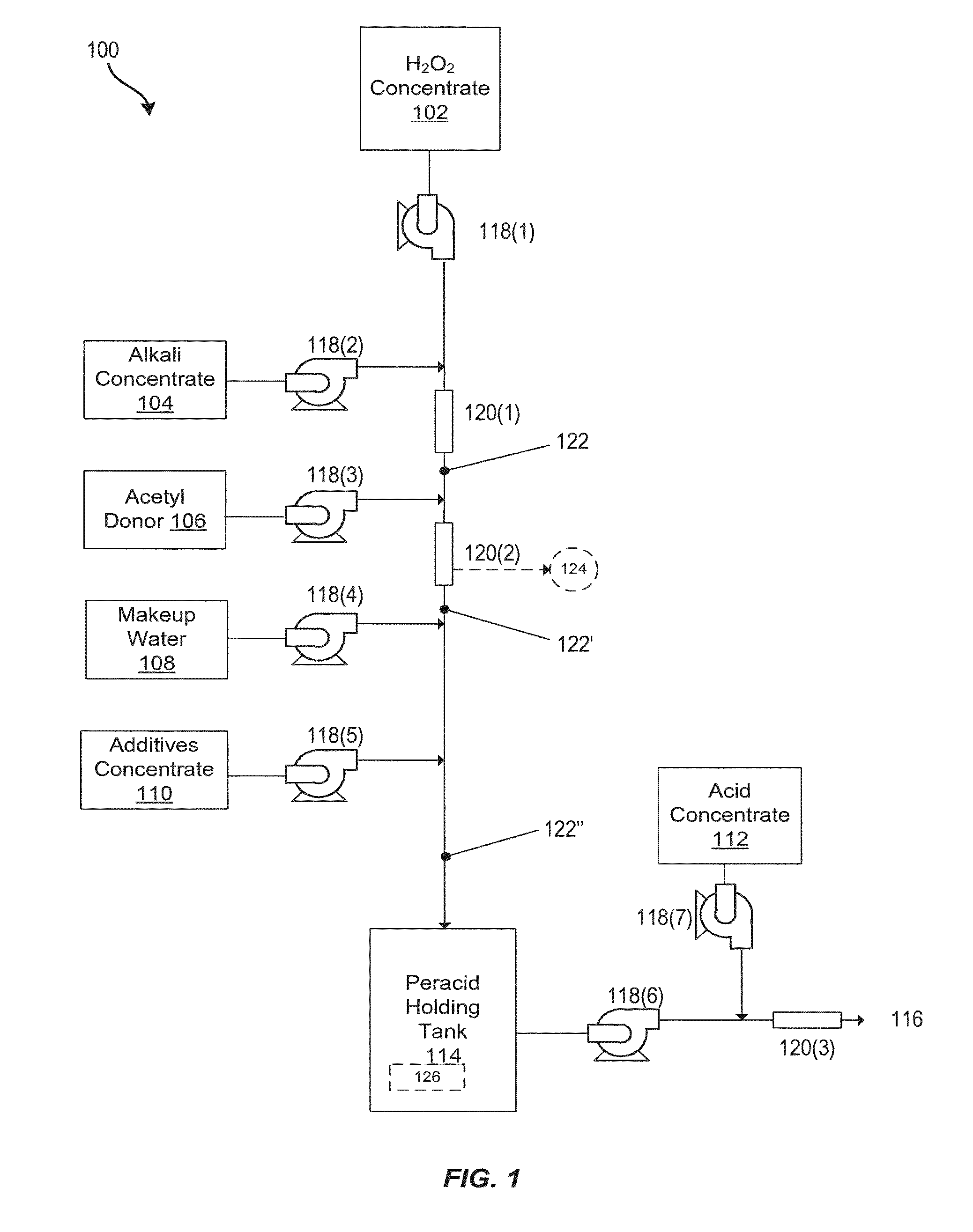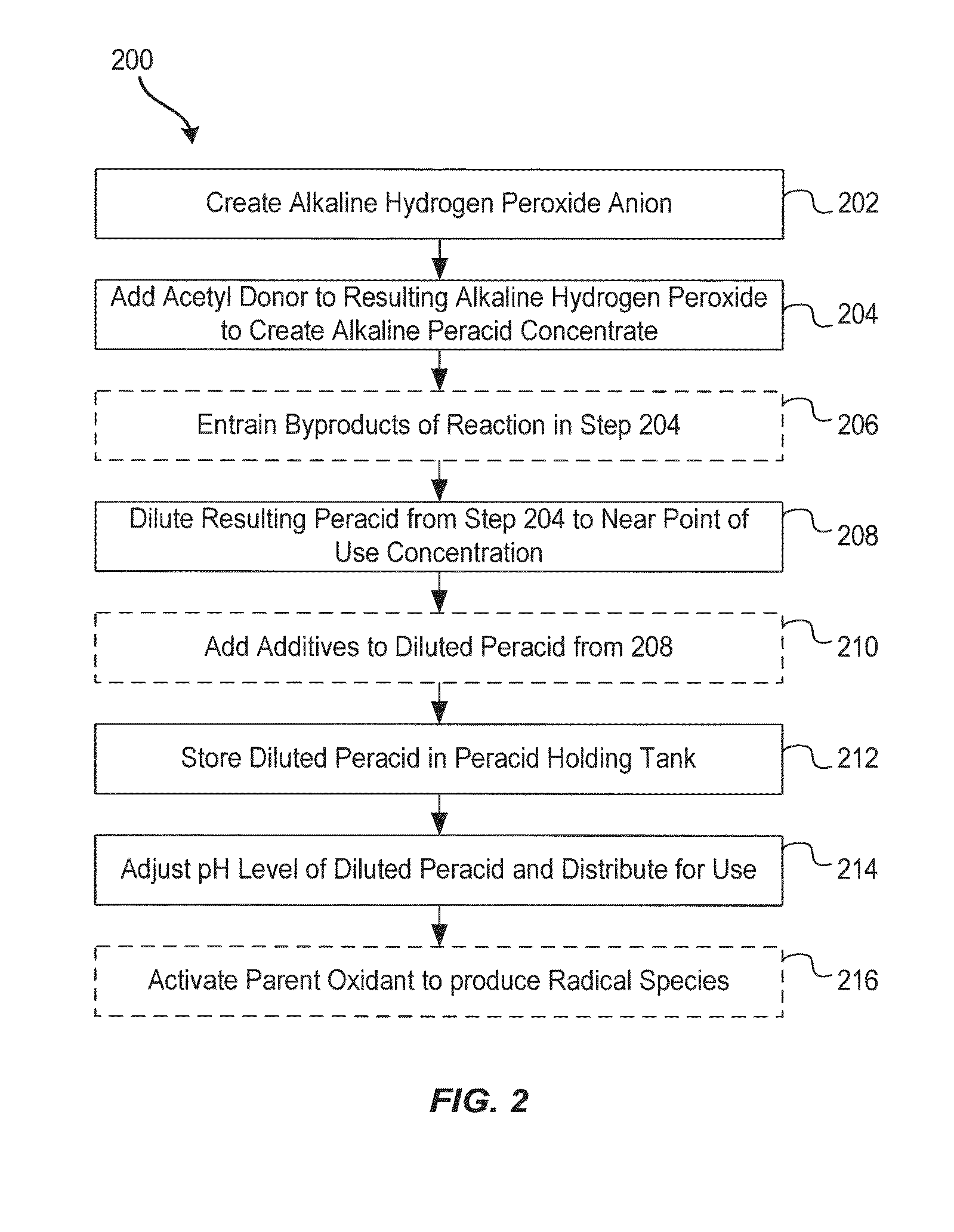System and method for generation of point of use reactive oxygen species
a technology of reactive oxygen species and system and method, which is applied in the field of system and method for generation of point-of-use reactive oxygen species, can solve the problems of inability to disinfection and other uses, short hydroxyl radical lifetime in aqueous media, and inability to oxidize halide salts with much lower standard potential,
- Summary
- Abstract
- Description
- Claims
- Application Information
AI Technical Summary
Benefits of technology
Problems solved by technology
Method used
Image
Examples
example 1
Cogeneration of Alkaline Hydrogen Peroxide and Citric Acid
[0178]A reactor system with the reactor of FIG. 6A and fluid process flow illustrated in FIG. 4 was used in this example. The cathode's active superficial area was approximately 255 cm2. The anolyte reservoir and chamber were charged with a 10% weight to volume solution of trisodium citrate in distilled water. A filtered compressed air stream was fed into the gas feed line at a rate of 5 liters per minute at 1.3 psig. A solution of 0.05 M sodium sulfate and 0.01 M sodium chloride in distilled water was fed into the catholyte feed line at a rate of 13 mL per minute at approximately 1.0 psig. A DC current was applied to the reactor at 5.0 amps and 4.55-4.65 volts. The catholyte output reached a steady state composition of 720 mg / L hydrogen peroxide with a pH of 12.4 (pH measured at a 20-fold dilution) within twelve minutes of applying the electric current and remained there at ambient temperature near 15° C. until the process c...
example 2
Generation of Hydrogen Peroxide by Cogeneration of Alkaline Hydrogen Peroxide and Sulfate Acids
[0180]A reactor system with the reactor of FIG. 6A and fluid process flow illustrated in FIG. 4 was used in this example. The cathode's active superficial area was approximately 255 cm2. The anolyte reservoir and chamber were charged with a 1.9 L solution of 0.25 M sodium sulfate in distilled water, initial pH=9.5. A ca. 93% oxygen gas stream generated by a pressure swing adsorption oxygen concentrator was circulated through the gas feed line at a rate of 14.5 liters per minute at 2.9 psig. A 0.02 M solution of sodium sulfate in distilled water was fed into the catholyte feed line at a rate of 12.8 mL per minute at 1.5 psig. A DC current was applied to the reactor at 7.0 amps and 3.7 volts between anode and cathode posts. The catholyte output reached a steady state composition of 2400 to 2450 mg / L hydrogen peroxide at a pH of 12.5 within twenty minutes of applying the electric current and ...
example 3
Cogeneration of Alkaline Hydrogen Peroxide and Sodium Hypochlorite
[0181]A reactor system with the reactor of FIG. 6A and fluid process flow illustrated in FIG. 4 was used in this example. The cathode's active superficial area was approximately 255 cm2. The anolyte reservoir and chamber were charged with a 1.8 L solution of 0.25 M sodium hydroxide and 0.067 M sodium chloride in distilled water, initial pH=13.2. A ca. 93% oxygen gas stream generated by a pressure swing adsorption oxygen concentrator was circulated through the gas feed line at a rate of 14.5 liters per minute at 3.0 psig. A 0.02 M solution of sodium sulfate in distilled water was fed into the catholyte feed line at a rate of 12.8 mL per minute at 1.7 psig. A DC current was applied to the reactor at 7.0 amps and 2.7 volts between anode and cathode posts. The catholyte output reached a steady state composition of 2300 to 2450 mg / L hydrogen peroxide at a pH of 12.6 within twenty minutes of applying the electric current an...
PUM
| Property | Measurement | Unit |
|---|---|---|
| pH | aaaaa | aaaaa |
| molar ratio | aaaaa | aaaaa |
| alkaline | aaaaa | aaaaa |
Abstract
Description
Claims
Application Information
 Login to View More
Login to View More - R&D
- Intellectual Property
- Life Sciences
- Materials
- Tech Scout
- Unparalleled Data Quality
- Higher Quality Content
- 60% Fewer Hallucinations
Browse by: Latest US Patents, China's latest patents, Technical Efficacy Thesaurus, Application Domain, Technology Topic, Popular Technical Reports.
© 2025 PatSnap. All rights reserved.Legal|Privacy policy|Modern Slavery Act Transparency Statement|Sitemap|About US| Contact US: help@patsnap.com



